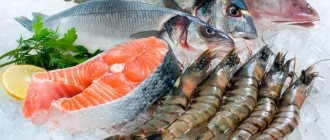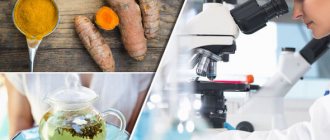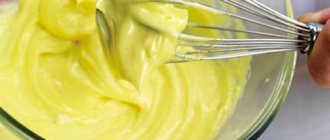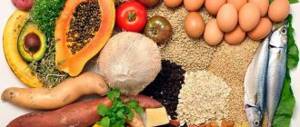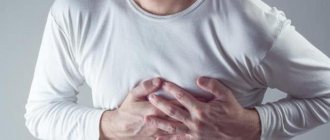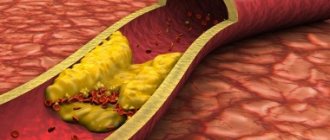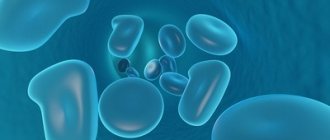General rules for atherosclerosis
A diet for atherosclerosis improves blood supply to the brain and neck, legs and other organs. The main principle is to reduce the consumption of exogenous cholesterol and fast, easily digestible carbohydrates.
To correctly create a menu for atherosclerosis, you need to follow a few simple rules:
- Limit salt to 5-10 g/day. During cooking, food is not salted. You can only add salt to ready-made dishes before eating.
- Avoid fried and deep-fried foods completely. Frying is a source of excess fat and calories. During frying, vitamins are destroyed, carcinogens are formed, which excite the central nervous system.
- Meat and fish are consumed only boiled (1-2 times/week can be baked in the oven, wrapped in foil).
- Fruits and vegetables are eaten raw or boiled or steamed as much as possible. Products high in coarse fiber are pre-chopped and then boiled.
- It is useful to consume garlic daily (if there are no diseases of the gastrointestinal tract), sprouts of oats, alfalfa, wheat, flax seeds, sesame seeds. They remove bad cholesterol, toxins, maintain vascular elasticity and intestinal function.
- Meals are fractional - 5 times a day in small portions. Hot and cold are excluded.
Vegetables, fruits, vegetable oils, fish, cottage cheese make up 60% of the basic diet. They contain a lot of ascorbic and linoleic acid, vitamin B, dietary fiber, potassium, and magnesium. These microelements remove cholesterol, slow down atherosclerosis, and support heart function.
Principles of diet for atherosclerosis
Nutrition principles of the diet for patients with atherosclerosis include:
- restriction or exclusion from the diet of foods that increase the level of low or very low density lipoproteins in the blood;
- determination of the maximum daily amount of cholesterol consumed (no more than 200 mg per day);
- reducing daily caloric intake;
- reduction or elimination of animal fats;
- reducing the volume of refined vegetable oil in the daily diet;
- reducing the amount of salt and spices, as well as adding salt to the finished dish;
- avoiding large amounts of sugar;
- determination of the minimum daily serving of proteins (from 150 g);
- introduction to the menu of a large number of foods rich in fiber, vitamins, microelements, amino acids.
When organizing nutrition for vascular atherosclerosis, you should also consider:
- balanced diet. Nutrition is aimed at improving the functioning of the heart, blood vessels, metabolic processes and reducing the risk of complications;
- need for weight loss. For obesity, the maximum daily caloric intake is calculated together with a nutritionist;
- menu composition. The predominance of vegetables and fruits in your diet will not only help you lose weight, but also improve your overall condition.
Attention must be paid to the correct combination of fats of plant and animal origin. Vegetable fats should account for more than 50% of the total volume. When increasing the amount of plant foods, it is recommended to include soy. It is especially useful for its chemical composition, physical properties and ability to replace meat. Constant consumption of soy leads to stabilization of lipid metabolism, improvement of blood composition and normalization of well-being.
Vitamins for atherosclerosis are necessary to maintain the functioning of the cardiovascular system, regulate sugar and cholesterol levels, and normal functioning of the body. They should be present in their natural form (in products) in the daily menu. The lack of vitamins of one group or another is compensated for by taking multivitamin complexes after a blood test and consultation with a doctor.
Diet for atherosclerosis
For atherosclerosis, the diet is made taking into account:
- time and amount of food taken;
- duration of intervals between meals;
- the value and chemical composition of the diet;
- volume and range of products.
Doctors recommend that when drawing up a menu, you should proceed from the following rules:
- amount of daily portion of salt - up to 8 g;
- the amount of daily portion of carbohydrates is no more than 400 g;
- the amount of daily portion of fat is up to 70 g for normal weight;
- the amount of protein at normal weight is calculated based on 1.5 microns per 1 kg of weight.
Calorie diet for atherosclerosis
For any type and form of atherosclerosis, the diet should prevent the accumulation of excess weight; for this purpose, the daily calorie content of the average diet is reduced by 10-15% for patients with normal weight (1900-2100 kcal per day), and by 15-20% for patients with any degree of obesity (from 1500 to 2000 kcal per day).
While reducing calories, there should be no reduction in the number of meals and the volume of food. This can provoke a decrease in blood glucose and, as a result, cause a strong feeling of hunger, which the patient will eat fast food or sweets. To prevent this from happening, it is advisable to adhere to the following recommendations:
- you need to eat more often than usual, and the serving size should not exceed 200-250 ml;
- the intervals between meals should not be more than 3-4 hours;
- It is advisable to have a fasting day 1 or 2 times a week;
- it is necessary to create a menu for several days to make it as varied as possible.
Varieties
There are two dietary options.
The first option for non-obese people: protein content - 90-100 g (half of it is of animal origin), fat - 80 g (half of vegetable origin), carbohydrates - 350-400 g (50 g of sugar per day in all dishes). The calorie content of this food option is 2600-2700 kcal.
The second option is prescribed for concomitant obesity and is characterized by a reduced amount of fat (up to 70 g per day), carbohydrates (300 g) and calorie content (2200 kcal).
What you can and cannot eat with atherosclerosis
Studies have shown that in atherosclerosis, the main danger is not cholesterol, but the lack of plant fiber and refined carbohydrates in food.
Allowed diet products for atherosclerosis
Daily consumption of approved foods for atherosclerosis, rich in plant fiber, amino acids, reduces cholesterol, restores vascular tone, improves blood supply to the heart muscle, lower extremities, and brain.
List of permitted products:
- any fresh, boiled vegetables, especially cabbage, eggplant, tomatoes, carrots, beets, zucchini;
- greens: parsley, dill, lettuce, beet tops, carrots, radishes;
- any fresh berries, fruits;
- fish: low-fat varieties of sea fish;
- seafood: squid, mussels, seaweed;
- egg whites, steamed egg whites;
- dairy products: milk, kefir (fat content up to 2.5%), low-fat natural yogurt, cottage cheese;
- cereals: buckwheat, rolled oats, millet, egg;
- flour products: rye, wheat, bran, grain bread, biscuits, dry unsweetened cookies, baked goods from bran dough without salt with meat, fish, vegetables;
- vegetable oils: olive, sunflower, corn;
- sweets: dried fruits, jellies, mousses, smoothies, sambuca with sugar substitute;
- drinks: black, green tea with milk or lemon, coffee drinks, chicory, fruit and vegetable juices, compotes, herbal infusions, rose hips.
The diet normalizes heart function and blood supply to internal organs in 2-3 months.
Partially limited diet foods for atherosclerosis
For atherosclerosis, limit foods of animal origin. They are consumed 2-3 times/week:
- lean types of meat: chicken, turkey (without skin), lean veal, beef, rabbit;
- egg yolk or soft-boiled eggs;
- butter;
- raisins, sugar, honey, jam (if you are overweight, exclude them completely);
- White rice;
- pasta;
- bitter chocolate;
- sour cream with a fat content of up to 15% (added only to ready-made dishes);
- low-fat cheese: tofu, ricotta, feta.
Prohibited diet foods for atherosclerosis
Prohibited foods for atherosclerosis, containing fast carbohydrates, trans fats, cholesterol (more than the daily norm). Dishes that increase the load on the digestive tract and intestines are prohibited.
Prohibited:
- vegetables: sorrel, spinach, radish, radish;
- mushrooms;
- fatty meat, fish, game;
- any types of offal;
- semi-finished products: sausages, sausages, dumplings, dumplings;
- smoked foods, marinades, canned food;
- fish, meat, mushroom rich broths;
- fatty dairy products;
- confectionery, baked goods, ice cream, cream;
- various sauces, mayonnaise, ketchup;
- cooking oil, spread, margarine;
- natural brewed coffee, strong black tea.
While following a diet, you can arrange fasting days 1-2 times a month. The most useful are fruits and vegetables. They eat 1.5-2 kg of boiled or fresh vegetables, fruits, and berries per day. However, such nutrition is contraindicated for diabetes mellitus, diseases of the gastrointestinal tract, kidneys, and liver.
Conditionally permitted types of food
Some foods with atherosclerosis are allowed to be eaten in limited quantities. They are not prohibited, but you should not abuse them. They should be included in the diet occasionally so that the patient does not feel hungry. These types of food include:
- Seafood. The patient can eat mussels, squid or seaweed in small quantities. This will enrich the body with iodine.
- Eggs. Proteins can be eaten every day and do not contain harmful lipids. As for yolks, they are included in the diet no more than 2-3 times a week.
- Fatty sea fish. This type of food is recommended for aortic damage. If the patient has cerebral atherosclerosis, then this product is excluded from the menu.
- Rye bread products. They can be eaten very moderately.
- Drink made from chicory. Patients with atherosclerosis are strictly prohibited from drinking coffee. This drink increases blood pressure and negatively affects blood vessels. If the patient is accustomed to the coffee taste, then a chicory surrogate can be used.
- Cheeses. This product can be eaten in very small quantities. In this case, you need to choose mild varieties.
- Fruits. Patients with atherosclerosis should not eat sweets: chocolate, ice cream, cakes. Therefore, many patients do not have enough sugar. To compensate for this deficiency, a small amount of sweet fruits and dried fruits are introduced into the diet: bananas, pears, prunes, dried apricots.
- Greenery. Parsley and dill are useful for atherosclerosis, but spinach, sorrel and raw onions should be avoided. Garlic is generally not recommended. However, for atherosclerosis, doctors advise using garlic tincture in moderate doses. This is a folk remedy for plaques in blood vessels.
Many patients are interested in: is it possible to eat potatoes with atherosclerosis? For vascular diseases, doctors usually recommend eating vegetables. But you need to remember that potatoes are quite high-calorie foods. Therefore, you need to eat it in moderation, since it is undesirable for a patient with atherosclerosis to gain weight. Potatoes are prepared boiled or baked. You should not fry this vegetable, such food is harmful. It is very useful to drink potato juice; it is a good folk remedy for the treatment of atherosclerosis.
Types of diets for atherosclerosis
Doctors and nutritionists have developed general rules of dietary nutrition for atherosclerosis, but each form of the disease has its own nuances and characteristics. Therefore, when composing a diet and selecting products, you need to take into account the type of disease and the presence of third-party chronic processes.
Diet for cerebral atherosclerosis
According to WHO statistics, cerebral atherosclerosis is one of the most common and dangerous diseases; organizing therapeutic nutrition for this form of the disease involves, in addition to diet, observing fasting days with low-fat cottage cheese, apples, kefir or buckwheat.
If you have problems with the blood vessels of the brain, you need to limit your intake of salt and foods with a lot of fat. And when cooking, use only pure vegetable oils. The diet should include more seafood and foods rich in ascorbic acid, vitamins, magnesium and potassium salts, and fiber.
Per day you need to consume:
- for overweight: 300 g carbohydrates, 90 g proteins, 70 g fats;
- for normal weight: 350 g carbohydrates, 80 g fat, 100 g protein;
- 1 liter of liquid;
- 1 g magnesium;
- 1.5 g phosphorus;
- essential vitamins: B1, B2, B6 - 3 mg each, PP - up to 30 mg;
- salt - no more than 5 g.
It is advisable to stick to 6 meals at regular intervals. The diet should include:
- low-fat dairy products;
- vegetable, fruit, berry juices without sugar;
- decoctions of berries, bran, herbs;
- rye bread, pastries without sugar and salt;
- first courses: vegetarian soups, weak broths;
- seafood;
- fresh vegetables (except potatoes);
- no more than eggs per week;
- any cereals except white rice.
You can drink coffee and tea with lemon. It is better to limit jam and honey, but jellies and mousses with low sugar content can be consumed every day. It is also better to reduce the amount of pasta on the menu, giving preference to steamed vegetables or cereals.
Diet for atherosclerosis with damage to the carotid arteries
The diet for atherosclerosis of the carotid arteries is aimed at eliminating cerebrovascular accidents, preventing the development of stroke and irreversible changes in the psyche. The diet is prescribed both as a preventive measure and for recovery after surgery.
According to the diet, food should be low in calories and contain a minimum of cholesterol. This therapeutic diet differs from the general diet for cerebral atherosclerosis in that it reduces the portion of dinner and eliminates any snacks between main meals.
Comments from nutritionists
When they say an atherogenic diet, what does that mean? Nutritionists mean that it is necessary to eliminate or reduce the amount of foods that contain animal and trans fats.
Consumption of trans fats causes cardiovascular pathologies, including atherosclerosis, and increases the mortality rate from these diseases. Therefore, WHO experts recommend avoiding eating food containing this component.
Diet No. 10c is prescribed for hypertension, cardiosclerosis, cerebral atherosclerosis, aortic atherosclerosis, coronary heart disease - IHD. Nutrition is selected in such a way as to reduce the progression of the disease and restore normal metabolism, including lipid metabolism.
Anti-atherosclerotic diet 10c comes in two interpretations. The prescription depends on the patient's body weight.
For insufficient and normal body weight:
- Proteins/fats/carbohydrates - 100/80/350 g (up to 50 g of sugar);
- Calorie content - 2.4–2.5 thousand kcal;
- Free liquid - 1.0–1.2 l;
- Salt - 5–7 g.
If you are overweight:
- Proteins/fats/carbohydrates - 90/70/300 g (up to 50 g of sugar);
- Calorie content - 2.1–2.2 thousand kcal;
- Free liquid - 1.0–1.2 l;
- Salt - 3–5 g.
A diet for atherosclerosis requires replacing saturated animal fats with unsaturated vegetable fats.
Polyunsaturated acids capture molecules from cell membranes and transport them to the liver for subsequent excretion, and also promote the formation of prostacyclin. The substance prevents platelet aggregation and the formation of microthrombi, reduces the risk of stroke and thrombosis.
In the diet of a patient with atherosclerosis, foods that lower cholesterol levels are preferred or do not pose a risk of increasing the level of this substance.
It is easier to prevent a disease than to treat it. Proper nutrition from the first days of life will help with this. In Western countries, in order to prevent pathologies of the heart and blood vessels, even a healthy population practices a simplified version of the 10c diet against atherosclerosis. The consumption of egg yolks and offal - kidneys, liver, brains - is excluded or limited from the diet.
Limit the amount of butter, sour cream, and fatty meat. Milk in dietary nutrition should not contain more than 1% fat. Chicken and turkey are consumed without skin. For meat, nutritionists recommend young lamb and lean beef.
It is recommended to eat any fish - sea or river; the vessels are protected by dishes made from cereals, vegetables, salad, fruits, legumes, and peanuts.
Taking care of your health and avoiding the consequences of atherosclerosis is not as difficult as it seems at first glance. Diet therapy for a disease is often effective without prescribing an anti-atherosclerotic drug, which does not always benefit the body.
The question is often asked: will fasting help cope with atherosclerosis? Indeed, therapeutic fasting can be used in the treatment of the initial stages of the disease. However, there are contraindications: arrhythmias, severe atherosclerosis, thyrotoxicosis, a tendency to thrombosis, liver and kidney pathology, and others.
In the absence of contraindications, short-term unloading can be carried out. However, the effectiveness of therapeutic fasting in the treatment of this disease is currently being questioned, and it has not been scientifically confirmed.
Some studies (on birds) have confirmed the opposite - metabolic disorders during fasting, on the contrary, lead to hypercholesterolemia.
The rule of life for such patients should be a balanced diet, and this dietary table meets all the requirements and takes into account all the main aspects of nutrition that lead to the progression of the disease.
It is very important to maintain high-density cholesterol levels. This is possible due to the daily intake of omega-3 PUFAs from food, since they are not formed in the body.
Their daily requirement is 2 g. As a guide, we present the content of 100 g of products: flax seed is in the lead - 22.8 g, walnuts are in second place - 6.8 g, mackerel - 2.5 g, herring - 1.5-3, 1 g, tuna - up to 1.6 g, soy - 1.6 g, salmon - 1.4 g.
This therapeutic food is relatively inexpensive and includes products used in everyday life. The main emphasis is on fruits, vegetables and cereals.
Based on the menu above, you can calculate that for a week you will need up to 2 kg of apples and tangerines, 1 kg of oranges and grapefruits, up to 3-4 kg of various vegetables and 1 kg of cereals. And also 0.5 kg of beef, 1 kg of chicken and 2 kg of fish.
The cost of a weekly menu is approximately 1700 - 1800 rubles.
Atherosclerosis is a serious disease that is caused by the accumulation of carbohydrates, lipids, calcium and other substances on the walls of blood vessels. Basically, it manifests itself in disorders of the endocrine and nervous system. If it manifests itself, you need a diet for vascular atherosclerosis.
Approximate daily diet for atherosclerosis
The daily diet for atherosclerosis should contain the correct ratio of proteins, fats, carbohydrates and a combination of foods. When creating a menu, it is advisable to adhere to the following scheme:
- Breakfast : carbohydrates (300-500 kcal). The goal is to recharge your batteries. Fruits, berries, cereals, juice.
- Lunch: proteins/fats/carbohydrates (800-1000 kcal). The goal is to saturate the body with nutrients. Meat, fish, vegetables, hot tea.
- Dinner: carbohydrates, proteins (300-500 kcal). The goal is to restore the strength spent during the day. Fish, cottage cheese, vegetables or cereals.
- Snacks: carbohydrates, proteins (100-200 kcal). The goal is to prevent feelings of hunger and overeating at lunch and dinner. Fruits, vegetables, whole grain bread, biscuits, juices.
Drink 1.2 liters of water during the day. 1-2 glasses in the morning on an empty stomach. The rest of the amount is half an hour before lunch, afternoon tea, dinner. Before going to bed, you can drink a glass of kefir. This improves the functioning of the digestive tract and relieves hunger.
What can you drink?
With atherosclerosis of the cardiac aorta, proper nutrition should be supplemented with natural and healthy drinks.
Doctors advise completely eliminating alcohol, soda, chocolate cocktails, and cocoa.
Coffee lovers may not give up their favorite drink, but consume only natural varieties. It is better if the coffee is diluted with milk. It is also recommended to choose weak black tea.
You can consume in unlimited quantities:
- clean water;
- mineral water without gases;
- compotes from fruits and dried fruits;
- vegetable and fruit juices;
- jelly;
- chicory;
- green tea and other herbal.
Herbal remedies help reduce the absorption of cholesterol in the intestines. Herbal medicine is effective for this pathology. Regular intake of decoctions and teas based on medicinal plants will not only not cause harm, but will also improve the patient’s condition:
- hawthorn;
- chamomile;
- rosehip;
- St. John's wort, etc.
For example, a collection of wild raspberry leaves, lingonberries, immortelle flowers and hawthorn fruits will help strengthen blood vessels. A teaspoon of the mixture is poured with boiling water (a glass), infused, and drunk during the day in 4 doses. Other herbal teas are also useful, but it is advisable to discuss their use with your doctor.
Sample diet menu for atherosclerosis for a week
An approximate weekly diet menu for atherosclerosis is presented below.
Monday
- breakfast – rolled oats with water, black or green tea;
- lunch - apple, handful of nuts, rosehip broth;
- lunch – lean borscht, boiled chicken breast, carrot and cabbage salad, hot tea;
- afternoon snack – yogurt, juice;
- dinner - potatoes, fish, seaweed.
Tuesday
- breakfast – cottage cheese, dried fruits, coffee drink;
- lunch – fruit and berry smoothie, chamomile tea;
- lunch - vegetable soup, meatballs, boiled beets with garlic, compote;
- afternoon snack – cottage cheese casserole, juice;
- dinner – carrot puree, baked chicken breast, jelly;
Wednesday
- breakfast – steam omelette, rolled oat porridge, ginger drink;
- lunch - fruit salad;
- lunch - fresh cabbage soup, boiled fish, zucchini, compote;
- afternoon snack - yogurt, chicory drink;
- dinner - egg, rabbit meatballs, tea.
Thursday
- breakfast – curd pudding, coffee with milk;
- lunch – fresh carrots, vegetable juice;
- lunch – Lenten pickle soup, fish baked with tomatoes, herbs, compote;
- afternoon snack – rose hip decoction, biscuits;
- dinner – steamed lazy cabbage rolls, carrot salad, jelly.
Friday
- breakfast – oatmeal with milk, chicory;
- lunch – baked apples, dried fruits, juice;
- lunch – beetroot soup, boiled veal, tea;
- afternoon snack – berry mousse, juice;
- dinner – chicken fillet, boiled vegetables, tea.
Saturday
- breakfast – cottage cheese with berries, fruits, coffee with milk;
- lunch – nuts, juice;
- lunch – lean borscht, steamed cutlets, tea;
- afternoon snack – casserole, compote;
- dinner - meat soufflé, fresh vegetable salad, tea.
Sunday
- breakfast – millet porridge, chicory;
- lunch – fruit, juice;
- lunch – vegetable casserole, boiled fish;
- afternoon snack – jelly, dry cookies;
- dinner – steamed meatballs, beet and carrot salad.
Authorized Products
What can you eat if you have atherosclerosis? In dietetics, it is customary to distinguish permitted, conditionally permitted and prohibited foods. For vascular diseases, the following products are considered useful and harmless:
- Vegetarian soups based on vegetable infusions. First courses should be served with fresh herbs. Parsley and dill help reduce swelling, which often affects patients. The menu for atherosclerosis should include vegetarian beet soup; this dish is rich in fiber and vitamins.
- Dietary types of meat. You should avoid eating beef, lamb, and pork, especially fatty varieties. It is useful to include poultry (chicken, turkey) and rabbit in the menu. Sometimes you can eat lean veal. Meat should be boiled, stewed or baked.
- Fish. This product should be included in the diet, as it is a source of protein and healthy omega acids. What fish can you eat if you have atherosclerosis? Preference should be given to low-fat types. Sea fish is more useful than river fish.
- Vegetable dishes from beets, cabbage, zucchini, eggplant. They can be boiled or stewed. Nutrition for atherosclerosis involves daily consumption of raw vegetables. Salads made from cucumbers and tomatoes are healthy, but they should not be flavored with mayonnaise. Vegetable oils should be used as a dressing.
- Products from unrefined cereals. They can be consumed in the form of porridges and side dishes.
- Fruit drinks, compotes, juices (except grape). You can also drink weak black or green tea.
- Fruits. This product is useful as it is a source of vitamins. However, you should not overuse sweet fruits.
- Dairy products. Such food should be included in the diet daily. However, we must remember that milk, cottage cheese or sour cream with a high percentage of fat content are harmful for atherosclerosis.
The benefits of dietary supplements for atherosclerosis
Dietary supplements or complexes of dietary supplements are actively used to prevent cardiovascular diseases, including atherosclerosis. They provide the body with vitamins, minerals, micro- and macroelements necessary for normal functioning.
Vitamins for atherosclerosis not only strengthen blood vessels and help regulate the functioning of the cardiovascular system, but are also natural antioxidants. Thus, vitamin C can reduce cholesterol in the blood, and in combination with bioflavonoids, it prevents vascular fragility.
Dihydroquercetin and other bioflavonoids reduce blood viscosity and improve the flow of oxygen to cells. Coenzyme Q10 is necessary for energy metabolism, and it also has membrane-stabilizing and antiarrhythmic effects. It is integrated into lipoproteins and prevents oxidative processes, which stops the progression of atherosclerosis. Many dietary supplements also contain important amino acids. Lysine prevents the deposition of lipoproteins on the walls of blood vessels and reduces the size of atherosclerotic plaques.
Ginkgo biloba extract contains ginkgolides, which reduce the risk of blood clots. The extract has vasodilating, antioxidant and antiarrhythmic properties, normalizes blood microcirculation in brain tissue, restores and strengthens the walls of blood vessels. Garlic extract reduces the production of cholesterol and lipids by liver cells, reduces blood clotting, reduces the risk of blood clots and blood sugar levels. Grape seed extract is rich in polyphenols, essential amino acids, vitamins and anthocyanins. It strengthens the walls of the arteries, increases their elasticity and improves blood flow.
Regular use of dietary supplements allows you to:
- reduce the risk of developing hypertension;
- prevent the development of varicose veins;
- increase physical and psycho-emotional endurance;
- improve overall well-being.
The use of dietary supplements is possible only after consultation with a doctor. They are usually taken in courses, three times a day during or after meals.
Pros and cons of diet for atherosclerosis
The therapeutic diet for atherosclerosis has a number of pros and cons:
| pros | Minuses |
|
|
List of products - taboo
In case of atherosclerosis of blood vessels, including veins and arteries of the lower extremities, it is necessary to completely exclude the following foods and drinks:
- Radishes and radishes of all varieties, sorrel and spinach.
- Bananas and grapes.
- Mushrooms of all varieties.
- Raisins, grape juice.
- Pasta.
- Jams, confitures, jams, pastries, cakes, chocolates, ice cream and many other confectionery products.
- Mayonnaise, cheese and other fatty sauces, mustard.
- Fat cheeses, cottage cheese and milk.
- Meat by-products: kidneys, liver, lungs, most sausages, salted and smoked lard, rich jellied meat.
- Smoked meats, marinades, canned food, pickles.
- Delicacy fish caviar, cod liver.
- Animal fats.
- Strong teas and coffee, especially instant varieties.
Diet for atherosclerosis and diabetes mellitus
Often atherosclerosis is combined with diabetes mellitus. What additions to the diet can be indicated here?
- Sugar must be excluded; natural stevia is recommended instead, but not artificial sweeteners.
- Fruits can raise sugar; every diabetic knows which fruits are prohibited.
- Protein from meat is not necessary for people with diabetes. It is replenished from fish, dairy products, and legumes.
Uncontrolled diabetes mellitus—high blood glucose levels—is one of the key factors in the formation of atherosclerotic plaques. It is very important to follow a diet and take glucose-lowering drugs or insulin, otherwise atherosclerotic growths will form extremely quickly.
Cardiology department specialists warn their patients: “Food supplements are your enemy! You shouldn't eat a single gram more than you need to feel full. All that follows is gluttony!” Yes, this is what people who save the lives of thousands of other people categorically teach us.
Everyone makes their own choice: throw away stereotypes, change their diet in the name of a long and healthy life, or stay with old preferences, gluttony and inferior foods. The latter ensures a short life.
Personal observations of doctors, as well as other people, have shown that the family budget, when switching to proper nutrition, not only does not change, but during the season of fresh vegetables and fruits it decreases.
Diet for atherosclerosis, reviews and results
The diet for atherosclerosis is designed for a long time, since it is balanced and contains a variety of foods. Some restriction in carbohydrates and fats does not adversely affect health, but on the contrary allows you to lose weight, normalize cholesterol and feel good. All these points are noted in the reviews of patients.
Ilona, 27 years old
Improved my health and lost weight. I liked this healthy diet. True, I was also prescribed pills to lower cholesterol;
Karina, 32 years old
I’m happy with the results: my cholesterol has dropped, my sugar levels have normalized, and I’ve even lost weight. Beauty!;
Alexandra, 34 years old
Cholesterol was not very high, so I managed only with therapeutic nutrition. I continue to eat like this;
Inna, 38 years old
My result is minus 5 kg, my general condition has improved significantly and my tests have become normal;
Karina, 32 years old
She helped me lose weight and improve my condition, but I think that the tests became normal thanks to the pills. I won’t push myself further and will eat right.
Svetlana, 52 years old
This is not even a diet, but proper nutrition. I see only benefits in low-fat dishes without frying or batter. I eat constantly, even though no one prescribed it for me. Cholesterol is normal.
Sources:
- https://MyHolesterin.ru/pitanie/dieta-pri-ateroskleroze.html
- https://sosudy.info/dieta-pri-ateroskleroze
- https://VenLife.ru/arterii-i-veny/ateroskleroz/pitanie-pri-ateroskleroze-1.html
- https://bloodvessel.ru/ateroskleroz/dieta-pri-ateroskleroze
- https://medside.ru/dieta-pri-ateroskleroze-sosudov
- https://azbyka.ru/zdorovie/dieta-pri-ateroskleroze-mozhno-li-maslo-sahar-i-myaso
How long should you diet?
The daily menu should be balanced, because the goal of this diet is not limited to weight loss (although in some cases this is necessary). It also does not have specific deadlines. The principles of diet therapy for atherosclerosis are as follows:
- Reducing cholesterol synthesis by reducing its intake through foods.
- Accelerating the removal of cholesterol from the body.
You may have to adhere to a balanced diet with a restriction of certain foods throughout your life, preventing the development and recurrence of the disease.
It is recommended to supplement the diet with regular physical activity.
Proper nutrition for aortic atherosclerosis slows down the course of both the disease itself and associated ailments. Often the pathology is associated with excess weight, so when creating a menu you need to pay attention to the caloric content of foods. The principles of a healthy lifestyle must be observed at all times.

